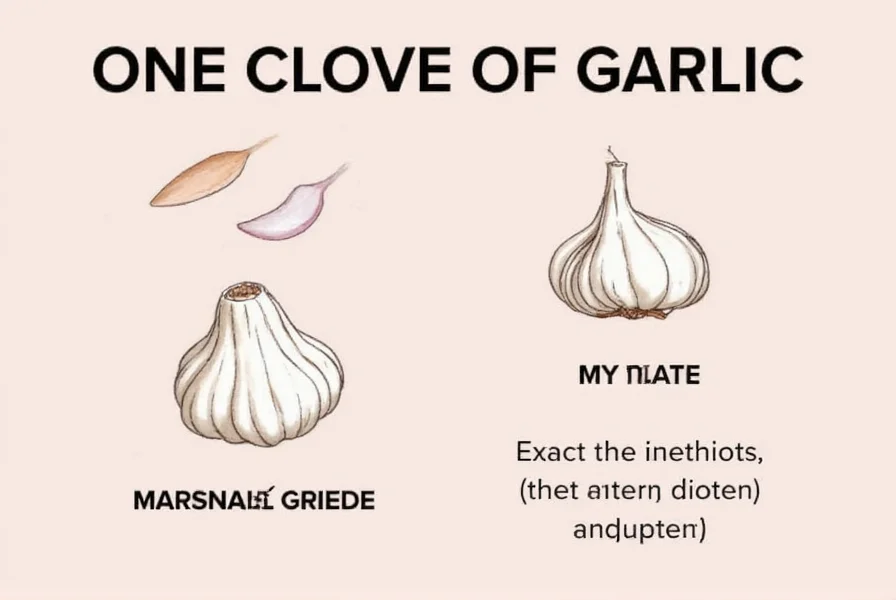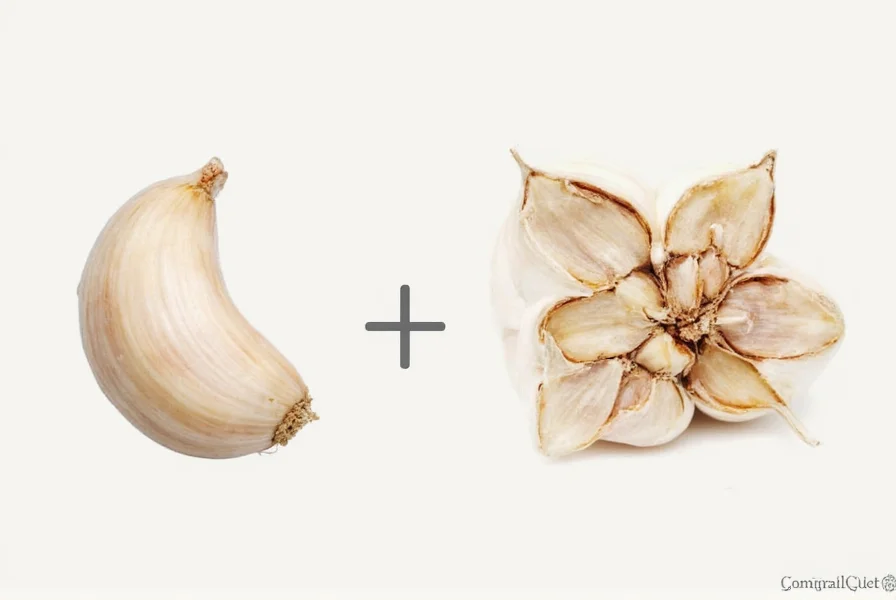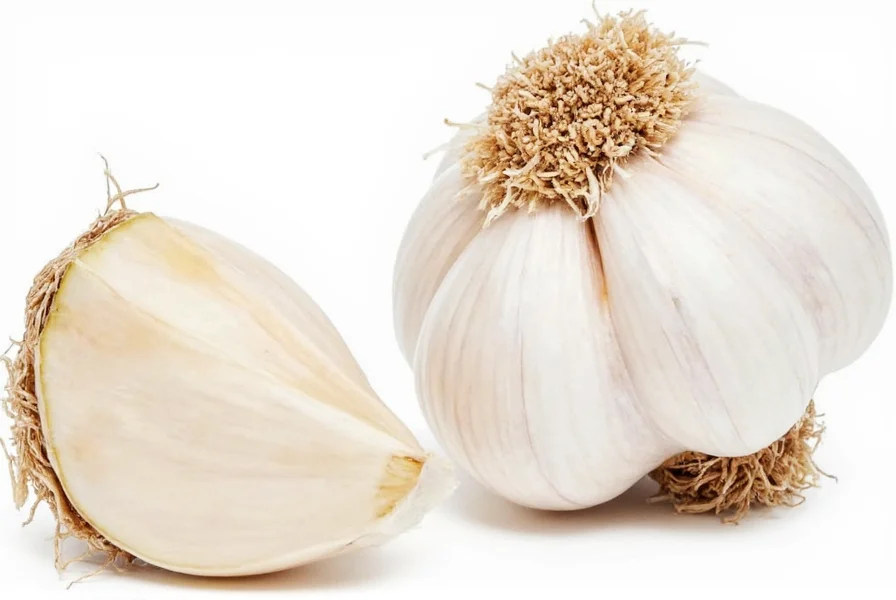Garlic is a staple ingredient in kitchens worldwide, but recipe instructions like 'add one clove of garlic' can leave home cooks wondering about exact measurements. Whether you're following a traditional recipe or adapting one for dietary needs, knowing the precise equivalent of one garlic clove ensures consistent results in your culinary creations.
Understanding Garlic Anatomy and Size Variations
Before exploring measurements, it's important to understand garlic's structure. A whole garlic unit is called a bulb or head, which contains multiple individual segments known as cloves. These cloves are wrapped in a thin, papery skin and grow clustered around a central stem.
Garlic cloves vary significantly in size depending on the variety and growing conditions. A single clove can range from:
- Small cloves: 3/4 inch long, 3/8 inch diameter (yields about 1/4 teaspoon minced)
- Medium cloves: 1 inch long, 1/2 inch diameter (yields about 1/2 teaspoon minced)
- Large cloves: 1 1/4 inches long, 5/8 inch diameter (yields about 3/4 teaspoon minced)
When recipes specify 'one clove of garlic,' they typically refer to a medium-sized clove unless otherwise indicated. This standardization helps maintain consistency in cooking results across different kitchens.
| Garlic Form | Equivalent to One Medium Clove | Notes |
|---|---|---|
| Fresh, whole | 1 clove | Peel before use |
| Minced fresh | 1/2 teaspoon | Finely chopped by hand or press |
| Garlic paste | 1/2 teaspoon | Commercial or homemade paste |
| Garlic powder | 1/8 teaspoon | Use 1/4 less when substituting for fresh |
| Garlic salt | 1/4 teaspoon | Contains added salt - adjust seasoning accordingly |
Practical Measurement Techniques for Cooking
Accurately measuring garlic can make the difference between a perfectly seasoned dish and an overpowering one. Here's how to handle different preparation methods:
For fresh cloves: When a recipe calls for 'one clove of garlic, minced,' first peel the clove, then finely chop it until you have approximately 1/2 teaspoon of minced garlic. Professional chefs often use the 'smash and chop' method - placing the flat side of a knife on the clove and pressing down firmly before mincing.
For substitutions: Understanding how much minced garlic equals one clove is crucial when adapting recipes. If you only have garlic powder but the recipe specifies fresh, remember that 1/8 teaspoon of powder equals one medium clove. This knowledge helps prevent the common mistake of using too much dried garlic, which has a more concentrated flavor.

Culinary Applications and Flavor Considerations
The form of garlic you use significantly impacts both flavor and aroma in your dishes. Whole cloves added to soups or stews provide a milder, more subtle garlic flavor that infuses throughout cooking. Minced garlic, however, releases more allicin (the compound responsible for garlic's characteristic flavor), creating a stronger, more immediate impact.
When determining how many teaspoons in one garlic clove for your specific recipe, consider these factors:
- Dish type: Delicate sauces benefit from finely minced garlic, while rustic stews can handle larger pieces
- Cooking time: Longer cooking times mellow garlic's sharpness, allowing for slightly more generous use
- Personal preference: Adjust measurements based on your taste preferences and dietary needs
For those wondering how to substitute for one clove of garlic when fresh isn't available, garlic paste offers the closest flavor profile. One-half teaspoon of paste equals one medium clove and provides consistent results without the preparation time of fresh garlic.
Nutritional Profile and Health Considerations
A single medium garlic clove (approximately 3 grams) contains:
- 4.5 calories
- 1 gram of carbohydrates
- 0.2 grams of protein
- Trace amounts of vitamins C and B6
- Small quantities of manganese and selenium
Garlic contains allicin, which forms when garlic is cut or crushed and has been studied for potential health benefits. While one clove of garlic daily may contribute to overall health, it's important to note that most research on garlic's health effects uses higher concentrations than found in typical culinary use.

Common Measurement Mistakes to Avoid
Many home cooks make these common errors when working with garlic measurements:
- Overestimating size: Using a large clove when a recipe assumes medium
- Incorrect substitution: Using equal amounts of powder instead of the proper 1/8 teaspoon per clove
- Improper mincing: Chopping too coarsely, resulting in uneven flavor distribution
- Adding too early: Burning garlic by adding it to hot oil before other ingredients
When converting recipes that specify 'one clove of garlic to tablespoons,' remember that even a large clove yields less than 1 tablespoon of minced garlic (typically 3/4 teaspoon, or 1/4 tablespoon). This common misconception leads many cooks to use excessive amounts.
Practical Tips for Garlic Measurement Success
For consistent results in your cooking, implement these professional techniques:
- When a recipe calls for multiple cloves, measure the total minced amount rather than counting cloves
- For precise control, use a microplane to create garlic paste directly into your dish
- When substituting dried for fresh, reduce the amount by 1/4 to avoid overpowering flavors
- Store peeled cloves in olive oil in the refrigerator for quick access to prepped garlic
- Roast whole cloves to mellow their flavor for dishes where you want subtle garlic notes
Understanding the exact measurement of one garlic clove transforms your cooking experience, allowing you to consistently achieve the perfect balance of flavors in every dish. Whether you're following a family recipe or experimenting with new cuisines, these precise measurements ensure your garlic usage enhances rather than dominates your culinary creations.
Frequently Asked Questions
How much minced garlic equals one clove?
One medium-sized garlic clove yields approximately 1/2 teaspoon of minced garlic. Small cloves produce about 1/4 teaspoon, while large cloves can yield up to 3/4 teaspoon when minced. For precise measurement, mince the garlic and use a 1/4 or 1/2 teaspoon measure to ensure accuracy in your recipes.
What is the equivalent of one clove of garlic in powder?
One medium garlic clove equals approximately 1/8 teaspoon of garlic powder. When substituting garlic powder for fresh garlic, use this ratio but remember that dried garlic has a more concentrated flavor, so you may want to start with slightly less and adjust to taste. Never use a 1:1 ratio when converting from fresh to powder.
Can I substitute garlic paste for fresh garlic cloves?
Yes, garlic paste makes an excellent substitute for fresh garlic cloves. One-half teaspoon of garlic paste equals one medium fresh garlic clove. The advantage of paste is consistent flavor and convenience, as it's already prepared and measured. When using commercial garlic paste, check for added ingredients like citric acid or oil that might affect your recipe's final flavor profile.
How many teaspoons are in one garlic clove when minced?
One medium garlic clove yields approximately 1/2 teaspoon of minced garlic. This measurement assumes the garlic is finely minced (not crushed into a paste). Small cloves yield about 1/4 teaspoon, while large cloves can produce up to 3/4 teaspoon. For recipes requiring precise measurements, it's better to measure the minced garlic rather than count cloves, as size variations can significantly impact flavor.
What's the difference between one clove of garlic and one head of garlic?
A single garlic head (or bulb) contains multiple individual cloves, typically 10-12 cloves in standard supermarket varieties. One clove refers to just a single segment of that bulb. When recipes specify 'one clove of garlic,' they mean one individual segment, not the entire head. Using an entire head instead of one clove would result in dramatically stronger garlic flavor that would likely overpower most dishes.











 浙公网安备
33010002000092号
浙公网安备
33010002000092号 浙B2-20120091-4
浙B2-20120091-4